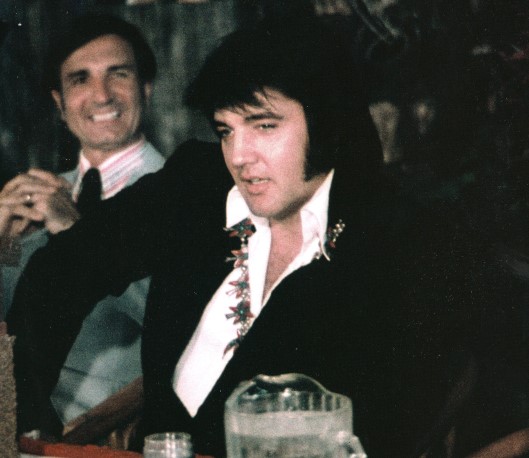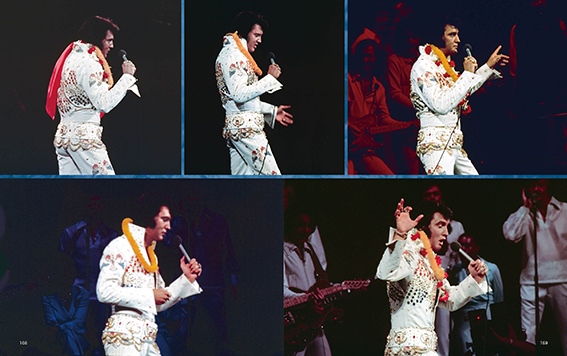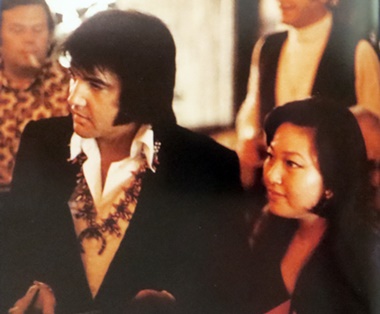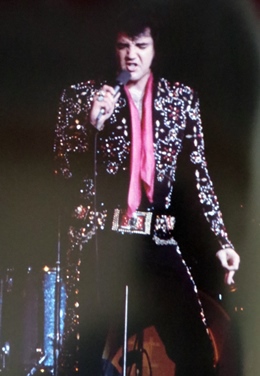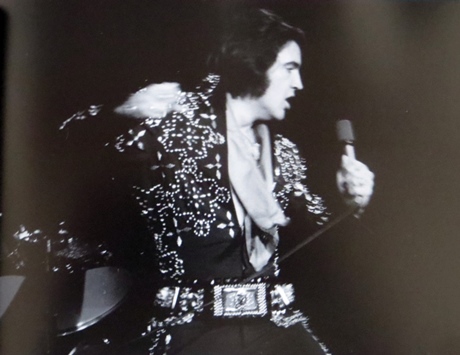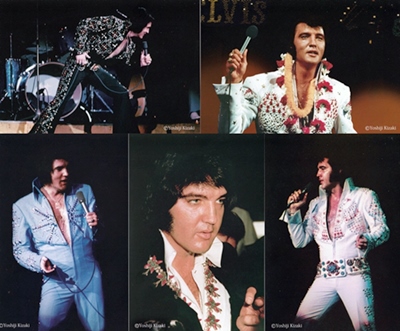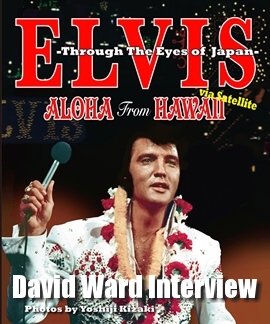 |
 |

'ELVIS: ALOHA FROM HAWAII - Through The Eyes of Japan' - Book review After a lengthy delay due to a print error this beautiful photo book of 'Elvis' Aloha From Hawaii - Through The Eyes of Japan’ was finally published this month. The publicity promised.. 50 years after Elvis’ legendary concert in Hawaii many valuable, long-lost negatives have been discovered, beautiful photographs taken by Japanese cameraman, Yoshiji Kizaki. The book is hard cover “deluxe size 290mm x 235mm”, 1.5kg and 200 pages. I was thrilled to finally receive this much anticipated book and my first impression was the joy in unwrapping a beautifully laid-out book with lovely thick paper and quality printing. And then the immediate delight of looking through hundreds of Elvis photos which were all brand new to me. The book features five main chapters focusing on four 1972 Elvis appearances plus the Aloha main concert. These are, November 17 1972 Evening Show, November 18 Afternoon Show and Evening Show, the November 20 Press Conference, finally the January 14 Aloha Special Satellite Show. Japanese photographer Yoshiji Kizaki provides a short forward including the obvious realisation that “With each performance, before I knew it we were at the end”.
How unusual it is to see any photographer actually with Elvis, but Kizaki not only met Elvis but also got his press pass signed by our hero! The book is 200 pages and features over 300 photos. Kizaki used three different cameras to photograph the concerts using both black-and-white and colour film. With the hundreds of photographs reproduced here it is of little surprise that some of them are slightly blurred or soft-focus but, as we all know, Elvis put on a very physical show so getting a static shot would always be a challenge. In any case some of the blurred action photos obviously help capture the excitement of Elvis on stage. A lot of the colour images are very impressive and so it is no surprise to learn that several of these photographs were used not only in marketing Elvis in Japan but also on Japanese vinyl album sleeves. There are some absolute beauties and the delight is that you will probably have never seen them before! His work overall is extremely impressive.
While this is obviously a photo book it is much more than that and if you read all the matching text it actually feels like a very personal journey. Unusually this is a book not filled with the normal newspaper articles and reviews of the concerts, this book is actually about how the Japanese team witnessed some of Elvis' greatest performances and became a crucial part in Elvis' most famous live broadcast. Looking through the photographs first, upon checking my volume of ‘Elvis Files 1971-1973’ I was surprised that Elvis’ three November 1972 performances are only covered with a few candid, usually distant, photographs. Here we get around fifty images from each concert. In ‘Elvis A Life in Music’ Ernst Jorgensen wrote “By the end of 1972 Elvis was definitely overweight” and I also remember that Marty Pasetta asked Elvis to lose weight for his Aloha concerts. So it is a surprise that these photographs actually show Elvis looking taught and terrific. In fact several of the images from his November 17 concert could easily be mistaken for his iconic Aloha performance!
Elvis’ November 17 concert – in his great Thunderbird jumpsuit and “Jack Lord” belt is covered over 35 pages and fifty-one photographs. It is a delight with Elvis looking on great form and very happy. How annoying we don’t have a soundboard to go with them – in fact nothing at all from Elvis’ final tour of 1972 apart from audience recordings and some good fan footage from Elvis’ November 13 San Bernadino concert.
Elvis’ Nov 17 concert with Aloha CD cover so you can judge the size of the photos.
Elvis’ November 18 2:30pm show in his fabulous Black Conquistador jumpsuit is covered over 35 pages. It's always been hard for photographers to capture Elvis in his black jumpsuits, so seeing so many gorgeous photographs of Elvis at this afternoon show is a real thrill.
Elvis’ November 18 8:30pm show with him luckily in yet another stunning jumpsuit, the blue Aztec Star is presented over 41 pages with lots of close-ups and action shots truly capture the excitement of the evening concert. Elvis sang his only 1972 live version of ‘Just Pretend’ at this special concert. Elvis November 20 Hilton Hawaiian Village Press Conference is covered by a fascinating twenty pages of photographs along with the transcript of his speech. Elvis neatly confirms that he would like to tour Japan, “I would like to come over there, I would like to get over to Japan”. Damn that Tom Parker!
The images capture Elvis looking relaxed, smiling and looking happy if also obviously tired. Some of these you might be familiar with as they have been used elsewhere and are in super-high quality. Finally the Aloha main show is covered in 35 pages. I was surprised that I had never seen any of these photographs before - even for example in the massive 300 page BoxCar ‘Aloha From Hawaii’ photo-book. These were all new to me and the interesting thing is that almost all the Aloha photographs we know are taken from the right-hand side of the stage whereas Kizaki was standing on the other side of the stage. The photo on the book's front cover is extraordinary.
A mixture of 35 colour and nine black-and-white photos you can feel the tension and excitement of watching Elvis at his most iconic performance.
As stated earlier, while this is obviously a photo book it is much more than that and it is the joy of all the Japanese team’s reminiscences matched with each chapter that makes the book a very personal journey.
Firstly music critic / songwriter Reiko Yukawa tells the story of bringing over hundreds of Japanese fans to Hawaii for Elvis’ November 1972 concerts and also how she was a key player at Elvis' press conference. The photo showing so many Japanese fans in the audience is astonishing. Once again these are people who actually met Elvis and talked with him. She was also obviously close to Parker's right-hand man Tom Diskin.
Shigehiro Ushikubo (Japanese TV director/ Producer) then explains how he became the producer of the Japanese version of the Aloha broadcast and how NTV Japan’s contribution of $730,000 was crucial in making the Aloha broadcast happen. This is a revelation to me since I cannot recall reading this in any Guralnick / Jorgensen book and with the figure being close to NBC’s $1million surely it should be a well-known fact. In Ushikubo’s story you can really feel his tension with producing the show, he nicely notes...
One of the Japanese team’s jobs was to super Elvis’ song titles in Japanese during the broadcast yet none of them had a proper run down sheet of what Elvis was about to sing. It sounds very tense!
Akiko Takahashi (right in the photo above) was RCA's Japanese director of Western pop music and she tells a great story of rush-releasing the album in Japan and so having to fly from Hawaii to LA studios for the album mix and then back to Tokyo with the master tapes. You know that the atmosphere would have been so tense and you can imagine that her job depended on getting it right. Like nearly all the Japanese team because of the work-pressure she has actually has no real memories of Elvis' performances which are all a blur to her. She explains..
A nice reveal is that James Burton appeared in the LA studio to help supervise the album mix down. Tokugen Yamamoto was head of RCA marketing and interestingly explains how much he was involved in getting South Korea to become involved in the Aloha broadcast (Long-haired rock’n’rollers were not acceptable in Korean culture at the time) while also getting the Philippines to show the broadcast despite the fact that martial law just been declared. He also talks about his involvement with Col Parker.
It is such a shame that none of the Hawaii November 1972 concerts were recorded on soundboard (or the tapes not yet found) since they would have been a very interesting comparison to Aloha itself. While I have seen a couple of Ed Bonja’s photographs from the November '72 concerts this delightful and stunning set of pictures beautifully capture this crucial period in Elvis’ on-stage career in great detail. My minor complaint is that I found it very odd that the concert photographs are sometimes not actually in chronological order. The Aloha series for instance starts with an image of Elvis not wearing his belt, yet we know this happened near the end. I also found that while listening to the concerts as I looked through the photographs I noticed more images out of order. Most fans would be aware of the complete Aloha performance and how Elvis put on the various leis around his neck throughout the show – yet here they are not in order. But perhaps I am becoming too pedantic after all these years since the book is still a brilliant selection of images showing the glory of Elvis on-stage.
PS: I forgot to mention in my initial review that I ordered the book early enough to receive the extra five postcards featuring the best shots from each event. They are a delightful bonus for keen collectors. See below.. Overall Verdict: At first glance you might imagine this is just another photo-book but it is much more than that. It is the story of the Japanese involvement in getting the Aloha broadcast actually produced and their input was far more crucial than I imagined. The Elvis Presley Society of Japan need to be congratulated for their work in putting this wonderful book together. With the telling of the Japanese team's personal stories you can truly feel the excitement of being there at the broadcast over 50 years ago. Having seen so few photos from Elvis’ November 1972 performances, plus all those intimate Press Conference photos, it is in fact the first 160 pages of the book that will truly delight any collector. The price of the book also makes it great value for money. A book that was well-worth the wait. Buy it before it sells out. These prices INCLUDE shipping and tracking - Europe 72.50 EUR / USA $84.50 / Australia AU$120 NOTE: To stop others copying & pasting, EIN has kept all the images used here deliberately low-res.
|
|








